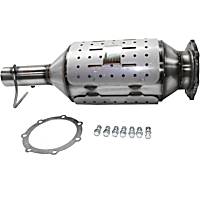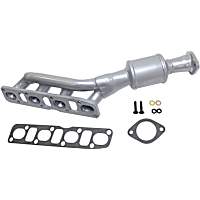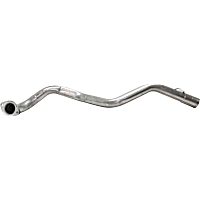Diesel engines have a lot of advantages aside from providing better torque. The catch is, they produce more soot, which is a black, carbon-based substance that is damaging to the atmosphere and to human health.
The diesel particulate filter (DPF) is a device that’s designed to eliminate soot emitted by diesel engines. It looks a lot like a catalytic converter, but the difference between them is that the DPF can regenerate or clean itself.
The process is usually automatic, but the P2002 error code will pop up when the DPF cannot perform efficiently.

What Does the P2002 Code Mean?
Diagnostic trouble code (DTC) P2002 stands for “Diesel Particulate Filter Efficiency Below Threshold (Bank 1).” As mentioned, the DPF can clean itself in a process called regeneration. This makes P2002 a soft code. When this code appears, it indicates that there is a problem in real-time and it goes away once the fault corrects itself.

What is a Diesel Particulate Filter?
The diesel particulate filter is an emissions control device positioned in the exhaust system of a vehicle. Inside the DPF is a ceramic honeycomb structure coated with compounds that help trap and eliminate soot.
The DPF accumulates a slight back pressure when operated. The feedback sensors on or near the DPF help the vehicle’s computer monitor its functionality. If there are irregularities in the pressure limits for two running cycles, the P2002 code appears. After successful regeneration, the P2002 will clear.
Diesel Particulate Filter Regeneration
DPF regeneration usually happens automatically. To be able to regenerate, the component needs to reach extreme temperatures. This is achieved when the vehicle is operated at speeds above around 40 mph (the exact speed may vary depending on the vehicle).
If these conditions aren’t met, the DPF will not regenerate as required and soot can build up inside it. In extreme cases, the DPF can become so clogged that it cannot regenerate and must be replaced. This typically happens in cases where there are so many short trips that the DPF doesn’t have sufficient time to regenerate. A flashing DPF light typically calls for a “service regeneration” procedure to be performed by a technician using a scan tool.
In extreme cases, the DPF (Diesel Particulate Filter Regeneration) can become so clogged that it cannot regenerate and must be replaced. This typically happens in cases where there are so many short trips that the DPF doesn’t have sufficient time to regenerate. A flashing DPF light typically calls for a “service regeneration” procedure to be performed by a technician using a scan tool.
–Richard McCuistian, ASE Certified Master Automobile Technician
The P2002 code is the same as the code P2003. The difference is, P2002 refers to bank 1 or the side of the engine that contains cylinder number 1. P2003, on the other hand, is in bank 2.
What are the Possible Causes of the P2002 Code?
Below are some of the issues that can trigger the P2002 code:
- DPF failure/damage
- Exhaust leak
- Excessive slow-speed or stop-and-go operation of the vehicle
- Defective exhaust back pressure sensor
Constant short-distance trips and stop-and-go traffic limit the speed and temperature at which the DPF can regenerate. As a result, the latter gets clogged and fails to function properly.
Fuels with high sulfur content can also cause the DPF to clog up. In some cases, the problem lies with the car’s software, although this is rare.

What are the Common Symptoms of the P2002 Code?
These are some of the signs you may observe when you get a P2002 code:
- Check engine light
- Reduced fuel economy
- Difficulty in starting the vehicle
- Poor acceleration
- Engine oil is diluted
- The engine goes into limp home (de-rated) mode
If the DPF fails to regenerate, the engine management system will attempt to increase the temperature of the exhaust so it can burn off the soot building up inside the DPF. As a result, the engine works harder and burns more fuel in the process. This increased engine activity may also cause the service life of the engine oil to shorten.
If the required speed and temperature to regenerate is not met and the DPF fails to regenerate, the engine will go into limp home (de-rated) mode until the situation is corrected. This will greatly reduce the performance of the engine and transmission, making it difficult to start and accelerate.
How to Diagnose the P2002 Code
Many problems can set the P2002 code, making it tricky to pinpoint its exact cause. Unless you are confident with your automotive know-how, diagnosing the DTC is a task best left to your mechanic.
The troubleshooting process can vary based on the vehicle’s make and model. If you drive a Ford vehicle, for instance, you can start your diagnosis by checking for black soot deposits in the tailpipe. Determine if the exhaust system tailpipe emits black smoke and check for leaks.
If you installed a new DPF recently, make sure the DPF parameter reset procedure was performed. You must also check for performance modifications and aftermarket exhaust accessories that diminish the exhaust restriction.
Take note that these are diagnostic instructions for certain Ford vehicles. To ensure you are following the right troubleshooting process, research troubleshooting guides that are specific to your car.
Don’t forget to check your owner’s manual before attempting a diagnosis.
How to Fix the P2002 Code
Many OBD-II DTCs share causes and symptoms, but that doesn’t mean that they can be resolved the same way—how they are fixed varies based on their exact cause.
Take note that you will need to find a fix that worked on a vehicle that’s the same as yours. For instance, the repair process for a P2002 code in a 2008 Ford F-250 Super Duty FX4 may involve cleaning/replacing the air cleaner element, replacing the DPF, or performing DPF regeneration.
When attempting DIY auto repair as a beginner, it’s best to consult online auto repair resources and guides to ensure that you have all the right information. For more comprehensive factory repair data, you can invest in an ALLDATA single-vehicle subscription. It will help you address not only the P2002 code but also any other automotive problems that you may encounter in the future.
Products Mentioned in this Guide
Any information provided on this Website is for informational purposes only and is not intended to replace consultation with a professional mechanic. The accuracy and timeliness of the information may change from the time of publication.


 Diesel Particulate Filter
Diesel Particulate Filter
 Catalytic Converter
Catalytic Converter
 Tail Pipe
Tail Pipe














